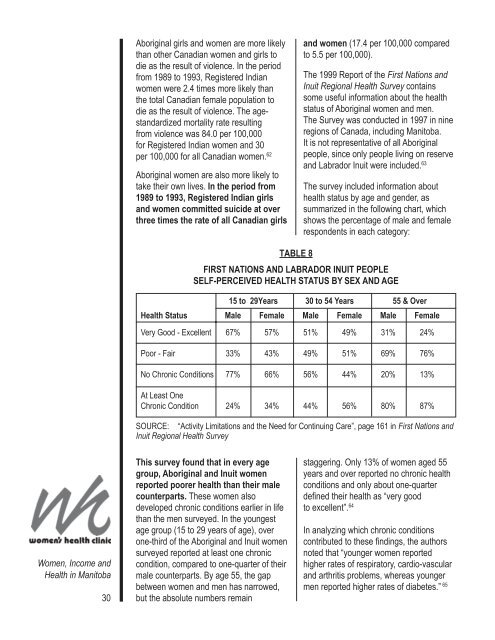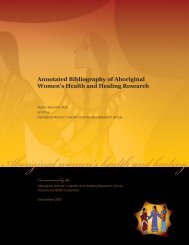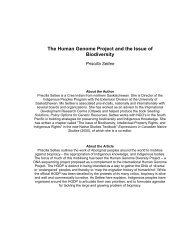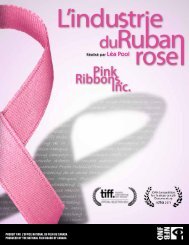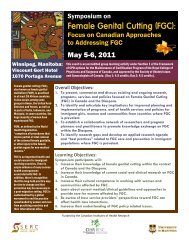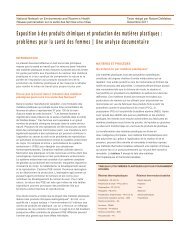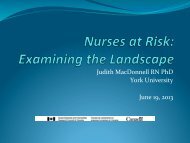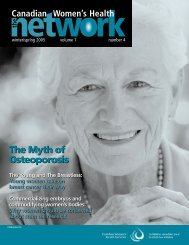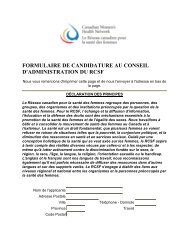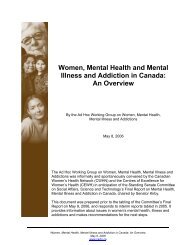here. - Canadian Women's Health Network
here. - Canadian Women's Health Network
here. - Canadian Women's Health Network
- No tags were found...
Create successful ePaper yourself
Turn your PDF publications into a flip-book with our unique Google optimized e-Paper software.
Aboriginal girls and women are more likelythan other <strong>Canadian</strong> women and girls todie as the result of violence. In the periodfrom 1989 to 1993, Registered Indianwomen were 2.4 times more likely thanthe total <strong>Canadian</strong> female population todie as the result of violence. The agestandardizedmortality rate resultingfrom violence was 84.0 per 100,000for Registered Indian women and 30per 100,000 for all <strong>Canadian</strong> women. 62Aboriginal women are also more likely totake their own lives. In the period from1989 to 1993, Registered Indian girlsand women committed suicide at overthree times the rate of all <strong>Canadian</strong> girlsand women (17.4 per 100,000 comparedto 5.5 per 100,000).The 1999 Report of the First Nations andInuit Regional <strong>Health</strong> Survey containssome useful information about the healthstatus of Aboriginal women and men.The Survey was conducted in 1997 in nineregions of Canada, including Manitoba.It is not representative of all Aboriginalpeople, since only people living on reserveand Labrador Inuit were included. 63The survey included information abouthealth status by age and gender, assummarized in the following chart, whichshows the percentage of male and femalerespondents in each category:TABLE 8FIRST NATIONS AND LABRADOR INUIT PEOPLESELF-PERCEIVED HEALTH STATUS BY SEX AND AGE15 to 29Years 30 to 54 Years 55 & Over<strong>Health</strong> Status Male Female Male Female Male FemaleVery Good - Excellent 67% 57% 51% 49% 31% 24%Poor - Fair 33% 43% 49% 51% 69% 76%No Chronic Conditions 77% 66% 56% 44% 20% 13%At Least OneChronic Condition 24% 34% 44% 56% 80% 87%SOURCE: “Activity Limitations and the Need for Continuing Care”, page 161 in First Nations andInuit Regional <strong>Health</strong> SurveyWomen, Income and<strong>Health</strong> in Manitoba30This survey found that in every agegroup, Aboriginal and Inuit womenreported poorer health than their malecounterparts. These women alsodeveloped chronic conditions earlier in lifethan the men surveyed. In the youngestage group (15 to 29 years of age), overone-third of the Aboriginal and Inuit womensurveyed reported at least one chroniccondition, compared to one-quarter of theirmale counterparts. By age 55, the gapbetween women and men has narrowed,but the absolute numbers remainstaggering. Only 13% of women aged 55years and over reported no chronic healthconditions and only about one-quarterdefined their health as “very goodto excellent”. 64In analyzing which chronic conditionscontributed to these findings, the authorsnoted that “younger women reportedhigher rates of respiratory, cardio-vascularand arthritis problems, w<strong>here</strong>as youngermen reported higher rates of diabetes.” 65


